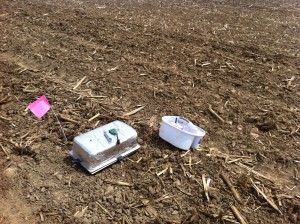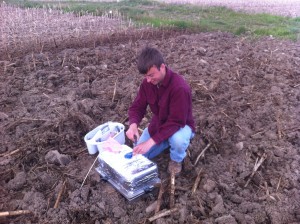As a member of the Nutrient Management Spear Program, I am assigned to a specific project with my field supervisor, but I, along with all interns, get involved in other projects happening within the Program. Cornell’s NMSP as well as various colleges and universities work collaboratively for the project “Dairy CAP” under the leadership of University of Wisconsin’s Dr. Matt Ruark. The NMSP’s part in Dairy CAP entails the greenhouse gas emissions project.
The objective of the NMSP’s greenhouse gas emission project is to quantify emissions from manure and compost, rate and timing for corn, and method of manure application (injected vs broadcast). Emissions were measured at Musgrave Farm in Aurora, NY on Field Z corn (5 replications, 50 plots total), alfalfa (6 replications, 24 plots total) and grass (6 replications, 24 plots total). In Field Z corn, there were organic and inorganic applications. For organic, phosphorus-based (P-based) and nitrogen-based (N-based) manure and compost was used. For inorganic, 0 lbs, 50 lbs, 100lbs, 150 lbs, and 200lbs per acre was used. N-based refers to the nitrogen needs as P-based refers to phosphorus needs
The three greenhouse gases (GHGs) measured in the project are carbon dioxide (CO2), methane (CH4) and nitrous oxide (N2O). CO2 is the least potent of the GHGs following CH4 (about 24 times more potent than CO2) and N2O (300 times more potent than CO2), the most potent GHG.
We use only one method for obtaining GHGs from the fields. This is what the typical setup looks like at Field Z:
A frame is hammered into the ground with a hammer and a piece of plywood. This serves as a platform to place the chamber and create an enclosed environment to capture GHGs. Clips are used to further seal the frame and chamber together to prevent GHGs from escaping.
A syringe is used to collect the GHGs from the setup when the needle is placed through a nob at the top of the chamber. Before insertion, the syringe must be “closed” to avoid other gases from entering the syringe and contaminating the sample. Once the needle is in the chamber, the syringe must be “opened” before GHGs can be drawn out, but the syringe must be closed before the needle is taken out of the chamber to prevent losing any GHGs collected inside the chamber and contaminants from entering the syringe. The sample is injected into a vial and later analyzed in the lab.
The collection of these samples takes place over an hour period. There are four “rounds” (T0, T1, T2, and T3) where 6 samples are collected from each replication in Field Z corn and 8 samples are collected from Field Z alfalfa and grass with the NMSP. Once the sampling begins in Field Z corn, there is a 2 minute interval between collecting each sample in each round, but in Field Z alfalfa and grass, each interval is 1.5 minutes since the chambers are closer together than chambers in Field Z corn.
We continuously sample from Field Z to determine when the greatest period of emissions occurs. Based from our findings, emissions appear the greatest after significant rainfall.


